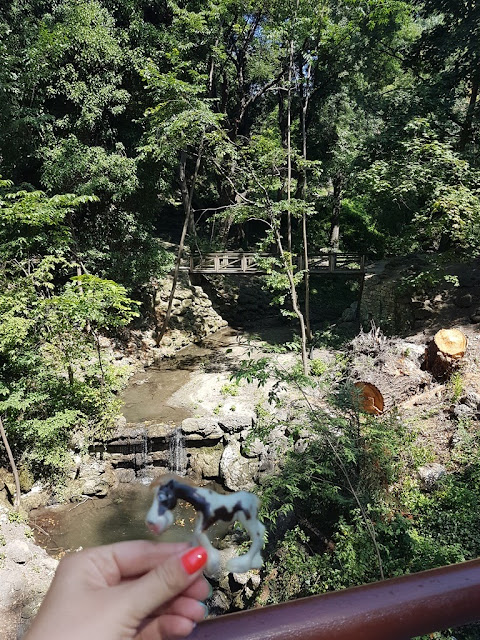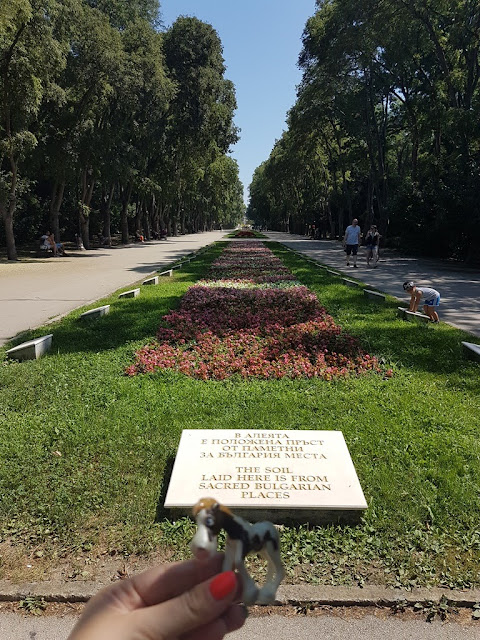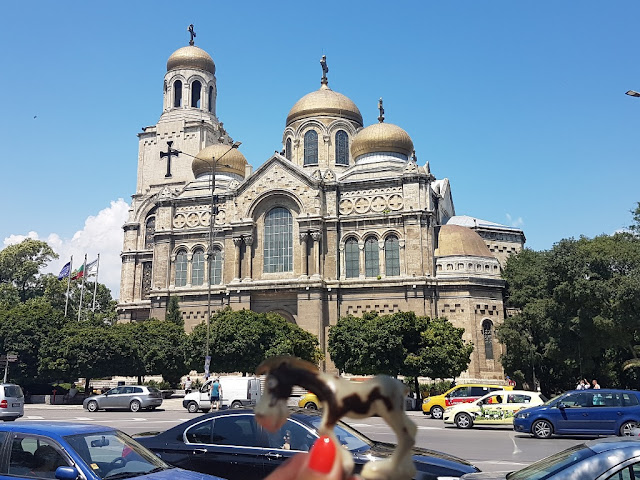From Aladzha we will drive only a few kilometres to the main city of the region - Varna. The history of human settlements in this region dates back to Antiquity. The city has been destroyed, burned, conquered and rebuilt several times, belonging in different periods to Romans, Bulgars and Turks. Actually more than once to each of them. Today, it is a nice coastal town, best know for its beach resorts called Golden Sands.
If you want to spend some time in the city rather than on the sand, you are likely to choose one of the city parks that offer the blessing of shadow.
You can sit on a bench.
Or take one of those pedalos if you wish to be close to water.
The small pond is supplied with water by a small river that runs into the sea.
You can also use this opportunity to learn more about Bulgaria and its sacred places and famous people.
Under each marble plate lies the soil from sacred Bulgarian places. Like here - the soil from the Dryanovo Monastery.
Down the lane, you can meet and greet some of the national heroes of different backgrounds. Vasil Levski was a revolutionist who was one of the fathers of the movement that led to the freedom of Bulgaria from the Ottoman Empire.
On the other hand, Simeon was a bishop of the Orthodox church taking care of the Varna and Preslav metropoly.
On a warm summer day, the city of Varna is of course very hot. I would still invite you to take a few steps out of the park and see some of the main landmarks.
You will undeniably find some churches ...
... a theater ...
... and nice residential buildings.
If you wish, you can greet the fisherman and his golden fish. Who knows, maybe she will grant you a wish if you are kind enough?
Or you can shake your hands with this nice gentleman. It is the architect Dabko Dabkov, who has designed and created over two hundred buildings in Varna in the beginning of twentieth century. The statue is placed in front of a building designed by Dabkov.
As we move down the pedestrian zone, we reach two more amoung the most important buildings in the city. First, the clock tower, built in 1888. The fire brigades of Varna used it to monitor the city from its top. If they spotted a fire during daytime they were passing signals with flags. At night, they used lanterns. The process stopped in 1898 when the fire brigade received a telephone line.
On the other side of the street you will find the second largest church in Bulgaria - the Cathedral of the Dormition of the Mother of God. It belongs to the Bulgarian Orthodox church that was established back in 870 AD.
Inside, the church is indeed very vast. It is also beautifully decorated.
In the main dome you will find, as in most of the orthodox churches that I have visited, a painting of Christos Pantocrator or otherwise Christ Almighty.
We cannot leave Varna without seeing one more place or one more personality. It is the horse of emperor (tsar) Kaloyan. In the twelfth century he carried his master to the independence of Bulgaria from the Byzantine Empire. We horses have always been vital to the freedom of nations!
If you want to spend some time in the city rather than on the sand, you are likely to choose one of the city parks that offer the blessing of shadow.
You can sit on a bench.
Or take one of those pedalos if you wish to be close to water.
The small pond is supplied with water by a small river that runs into the sea.
You can also use this opportunity to learn more about Bulgaria and its sacred places and famous people.
Under each marble plate lies the soil from sacred Bulgarian places. Like here - the soil from the Dryanovo Monastery.
Down the lane, you can meet and greet some of the national heroes of different backgrounds. Vasil Levski was a revolutionist who was one of the fathers of the movement that led to the freedom of Bulgaria from the Ottoman Empire.
On the other hand, Simeon was a bishop of the Orthodox church taking care of the Varna and Preslav metropoly.
On a warm summer day, the city of Varna is of course very hot. I would still invite you to take a few steps out of the park and see some of the main landmarks.
You will undeniably find some churches ...
... a theater ...
... and nice residential buildings.
If you wish, you can greet the fisherman and his golden fish. Who knows, maybe she will grant you a wish if you are kind enough?
Or you can shake your hands with this nice gentleman. It is the architect Dabko Dabkov, who has designed and created over two hundred buildings in Varna in the beginning of twentieth century. The statue is placed in front of a building designed by Dabkov.
As we move down the pedestrian zone, we reach two more amoung the most important buildings in the city. First, the clock tower, built in 1888. The fire brigades of Varna used it to monitor the city from its top. If they spotted a fire during daytime they were passing signals with flags. At night, they used lanterns. The process stopped in 1898 when the fire brigade received a telephone line.
On the other side of the street you will find the second largest church in Bulgaria - the Cathedral of the Dormition of the Mother of God. It belongs to the Bulgarian Orthodox church that was established back in 870 AD.
Inside, the church is indeed very vast. It is also beautifully decorated.
In the main dome you will find, as in most of the orthodox churches that I have visited, a painting of Christos Pantocrator or otherwise Christ Almighty.
We cannot leave Varna without seeing one more place or one more personality. It is the horse of emperor (tsar) Kaloyan. In the twelfth century he carried his master to the independence of Bulgaria from the Byzantine Empire. We horses have always been vital to the freedom of nations!
















































